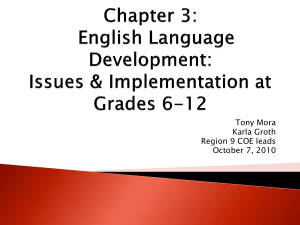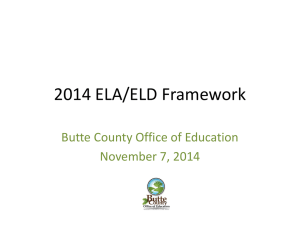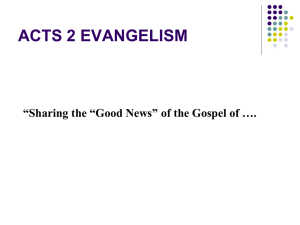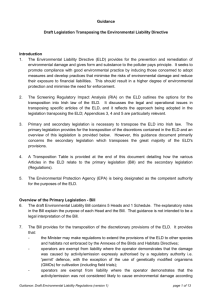The Environmental Liability Directive (`ELD`)
advertisement
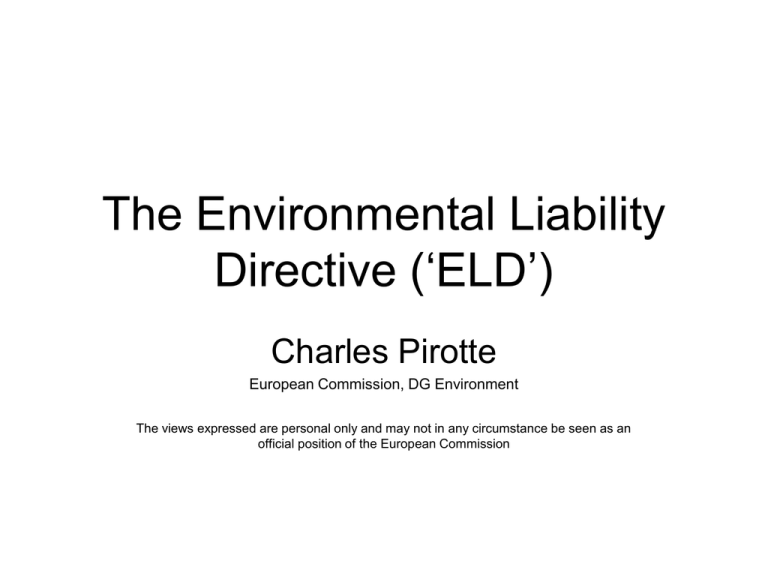
The Environmental Liability Directive (‘ELD’) Charles Pirotte European Commission, DG Environment The views expressed are personal only and may not in any circumstance be seen as an official position of the European Commission ELD – A Long Story • • • • • Green Paper 1993 White Paper 2000 Working Document 2001 Legislative proposal 2002 Directive adopted by European Parliament and Council on 21.4.2004 ELD – An Overview (I) • EU framework based on the polluter-pays principle on the prevention and remedying of certain types of environmental damage (protected species and natural habitats, soil and water). • Framework Directive leaving wide margin of discretion to Member States on certain important issues (permit and development risk defences, financial security, joint and several or proportional liability). ELD – An Overview (II) • Focus on ‘restoration in kind’ (restore, rehabilitate or replace damaged natural resources and/or impaired services, or to provide an equivalent alternative to those resources or services – see Annex II). • Breaking new ground in Europe on certain difficult technical issues as to how to ensure restoration in kind of damaged natural resources (e.g. ‘interim losses’). • Financial security providers (such as insurers), encouraged to develop over time appropriate and affordable products covering environmental liability risks. ELD – Key definitions (Art. 2) (I) • Definition of operator Operator means any natural or legal, private or public person who operates or controls the damaging occupational activity or, where this is provided for in national legislation, to whom decisive economic power over the technical functioning of such an activity has been delegated, including the holder of a permit or authorisation for such an activity or the person registering or notifying such an activity. ELD – Key definitions (Art. 2) (II) • Definition of environmental damage – There are three categories of environmental damage under the ELD: – (a) “damage to protected species and natural habitats”, which is any damage that has significant adverse effects on reaching or maintaining the favourable conservation status of such habitats or species. The habitats and species concerned are defined by reference to species and types of natural habitats identified in the relevant parts of the Birds Directive 79/409 and the Habitats Directive 92/43; ELD – Key definitions (Art. 2) (III) – (b) “water damage”, which is any damage that significantly adversely affects the ecological, chemical and/or quantitative status and/or ecological potential, as defined in the Water Framework Directive 2000/60, of the waters concerned; – (c) “land damage”, which is any land contamination that creates a significant risk of human health being adversely affected as a result of the direct or indirect introduction, in, on or under land, of substances, preparations, organisms or micro-organisms. ELD - Scope (Art. 3) • Basic features: – Two liability regimes: • (a) environmental damage/imminent threat when caused by Annex III activities; • (b) damage to protected species and natural habitats/imminent threat when caused by non-Annex activities if operator at fault or negligent. • Causal link. – Without prejudice to more stringent Community legislation. – Does not give private parties a right of monetary compensation. ELD – Liability Matrix (I) Who? How? What? Water damage Annex III operators Causal link but fault/negligence not a prerequisite Damage to protected species and natural habitats Land damage ELD – Liability Matrix (II) Who? Non-Annex III operators How? What? Causal link + Damage to fault/negligence protected species and natural habitats ELD – Exceptions (Art. 4) • ELD does not cover damage/imminent threat when: – Caused by: • (a) an act of armed conflict, hostilities, civil war or insurrection; • (b) a natural phenomenon of exceptional, inevitable and irresistible character. – Covered by Annexes IV and V International Conventions. – Caused by certain activities: • Nuclear activities covered by Euratom. • National defence/international security/protection from natural disasters. – Caused by diffuse pollution (i.e. when no causal link). ELD – Prevention (Art. 5) • Prevention – Imminent threat of damage => operator to take preventive actions (Art. 5(1)). – Operator to inform the competent authority (CA) if threat persists (Art. 5(2)). – Powers of CA towards the operator (Art. 5(3)&(4)): “getting the work done”. – Discretionary subsidiary action by the CA (Art. 5(4)). ELD – Remediation (Art. 6 & 7) • Remediation – Operator to inform the competent authority (CA) if threat persists (Art. 6(1)). – Operator to take emergency containment/mitigation measures (Art. 6(1)(a)). – Operator to take remedial measures (Art. 6(1)(b)). – Powers of CA towards the operator (Art. 6(2)&(3)): “getting the work done”. – Discretionary subsidiary action by the CA (Art. 6(3)). • Operator to develop and propose remediation plans to CA for approval (Art. 7 & Annex II). ELD – Costs (Art. 8) • Operator to bear the costs of preventive and remediation actions under the ELD (Art. 8(1) & (2)), except when: – third party causation (despite the fact that appropriate safety measures were in place) (Art. 8(3)(a)); – compliance with a compulsory order or instruction emanating from a public authority (Art. 8(3)(b)); or – when Member State decides to introduce: • Permit defence (Art. 8(4)(a)), and/or • Development risk/state of the art defence (Art. 8(4)(b)). ELD – Costs (Article 8(4)) • 4. The Member States may allow the operator not to bear the cost of remedial actions taken pursuant to this Directive where he demonstrates that he was not at fault or negligent and that the environmental damage was caused by: • (a) an emission or event expressly authorised by, and fully in accordance with the conditions of, an authorisation conferred by or given under applicable national laws and regulations which implement those legislative measures adopted by the Community specified in Annex III, as applied at the date of the emission or event; • (b) an emission or activity or any manner of using a product in the course of an activity which the operator demonstrates was not considered likely to cause environmental damage according to the state of scientific and technical knowledge at the time when the emission was released or the activity took place. ELD – Cost & time-limits • Cost allocation in cases of multiple party causation (Art. 9) – MSs to decide whether proportional vs joint-andseveral liability. • Limitation period for recovery of costs (Art. 10) – To be initiated within five years from the date on which those measures have been completed or the liable operator, or third party, has been identified, whichever is the later. • Overall time-limit (Art. 17 3rd indent) – ELD does not apply to damage, if more than 30 years have passed since the emission, event or incident, resulting in the damage, occurred. ELD – Competent authority/ies (Article 11) • Duties: – To establish who caused damage. – To assess the significance of the damage. – To determine Annex II remedial measures. • Powers: – Various powers toawards the operator (see Art. 5(3) & 6(2)). Procedural safeguards: – CA decision to be reasoned, notified forthwith to the operator, who is to be informed of the legal remedies available and their time-limits. ELD – Request fo action & review (Art. 12 & 13) • Interested natural and legal persons entitled to request CA to take action. • If prima facie case supported by relevant data, CA to investigate and made a decision as to action is warranted ort not, taking into account views of the operator concerned. • Procedure optional in cases of imminent threat of damage. • Article 12(1) persons to have access to a court/other independent and impartial public body to review CA's behaviour. • National procedure rules remain otherwise unaffected. ELD – Financial security (Art. 14) & transboundary damage (Art. 15) • Financial security: – MSs to encourage the development of financial security instruments and markets. – Commission to report before 30 April 2010 and, if appropriate, to submit proposals for a system of harmonised mandatory financial security. • Cooperation between Member States: – Where damage affects or likely to affect several Member States, duty on those to cooperate to ensure preventive action and/or remedial action is taken. – Duty to provide sufficient information to the other Member States. – MS affected may recommend preventive/ remedial measures & seek to recover costs incurred. ELD – National law (Art. 16) & temporal application (Art. 17) • Relationship with national law (Art. 16): – ELD = minimum requirements since MSs not precluded to maintain/adopt more stringent provisions. • This includes: identifying additional activities to be covered and/or additional responsible parties. – MSs may adopt measures on double recovery. • E.g. concurrent action by CA and by a person whose property is affected by environmental damage. • Transitional law (Art. 17 1st & 2nd idents): – ELD has no retrospctve effect: it does not apply to: • damage caused by an emission, event or incident that took place before 30.4.2007, • damage caused by an emission, event or incident which takes place after 30.4.2007 when it derives from a specific activity that took place and finished before the said date. ELD – Final provisions • Reports and review (Art. 18): – Cion to report to Council & EP by 30.4.2014 on the basis of MSs reports (see Annex VI). – Mandatory items to be reviewed by Cion in its report listed in Art. 18(2). • Implementation (Art. 19): – ELD to be implemented by 30.4.2007. ELD – Annexes I and II (I) • Annexes – Annex I • How to assess significance of damage that has adverse effects on reaching or maintaining the favourable conservation status of habitats or species. – Annex II • Common framework to be followed in order to choose the most appropriate measures to ensure the remedying of environmental damage. • Remediation of damage to water or protected species or natural habitats: achieved through the restoration of the environment to its baseline condition by way of primary, complementary and compensatory remediation. ELD – Annex II (II) • Annex II (c’ted) – Remediation of damage to water or protected species or natural habitats • “Primary” remediation: any remedial measure which returns the damaged natural resources and/or impaired services to, or towards, baseline condition. • “Complementary” remediation: any remedial measure taken in relation to natural resources and/or services to compensate for the fact that primary remediation does not result in fully restoring the damaged natural resources and/or services. • “Compensatory” remediation: any action taken to compensate for interim losses of natural resources and/or services that occur from the date of damage occurring until primary remediation has achieved its full effect. ELD – Annex II (III) • Remediation of land damage – Measures to be taken to ensure that the relevant contaminants are removed, controlled, contained or diminished so that the contaminated land, taking account of its current use or approved future use at the time of the damage, no longer poses any significant risk of adversely affecting human health. ELD – Annex II Matrix Primary Baseline Same resources on damaged site Complementary Same resources on different site and/or different but similar resources on damaged site (scaling Compensatory Indifferent since topped-up on primary/compl. ELD – Annex III • Annex III: activities subject to strict liability, such as: – – – – – IPPC installations. Waste management. Waste shipments. Releases of polluting substances. Manufacture, use, storage, processing, filling, release into the environment and onsite transport of: • dangerous substances & preparations; • Plant protection products & biocides. – Contained use and delibate releas of GMOs.


